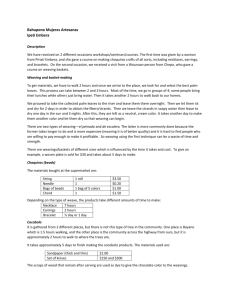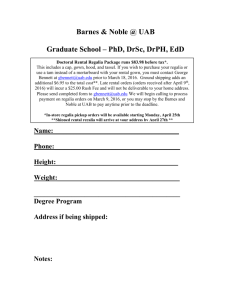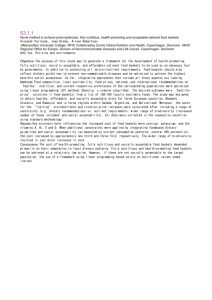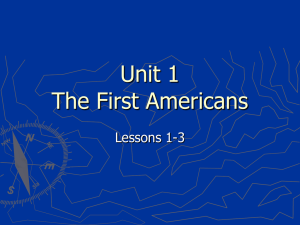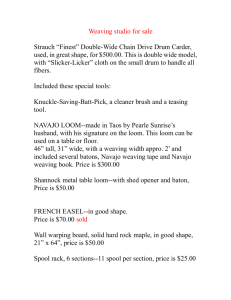HIBBING COMMUNITY COLLEGE
advertisement
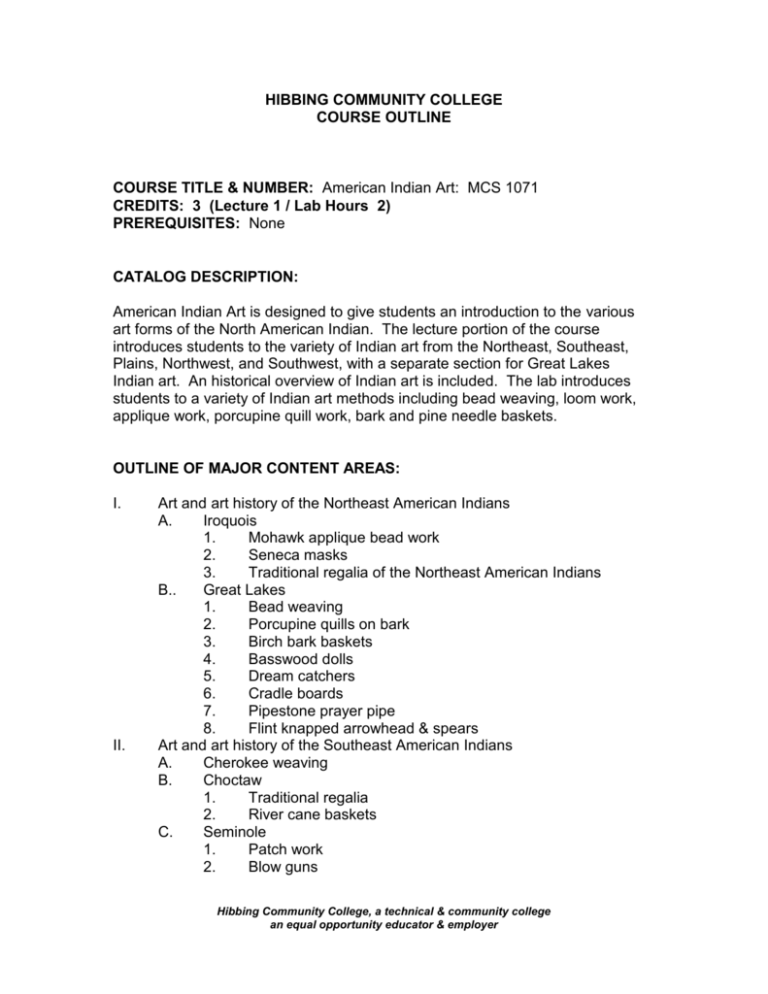
HIBBING COMMUNITY COLLEGE COURSE OUTLINE COURSE TITLE & NUMBER: American Indian Art: MCS 1071 CREDITS: 3 (Lecture 1 / Lab Hours 2) PREREQUISITES: None CATALOG DESCRIPTION: American Indian Art is designed to give students an introduction to the various art forms of the North American Indian. The lecture portion of the course introduces students to the variety of Indian art from the Northeast, Southeast, Plains, Northwest, and Southwest, with a separate section for Great Lakes Indian art. An historical overview of Indian art is included. The lab introduces students to a variety of Indian art methods including bead weaving, loom work, applique work, porcupine quill work, bark and pine needle baskets. OUTLINE OF MAJOR CONTENT AREAS: I. II. Art and art history of the Northeast American Indians A. Iroquois 1. Mohawk applique bead work 2. Seneca masks 3. Traditional regalia of the Northeast American Indians B.. Great Lakes 1. Bead weaving 2. Porcupine quills on bark 3. Birch bark baskets 4. Basswood dolls 5. Dream catchers 6. Cradle boards 7. Pipestone prayer pipe 8. Flint knapped arrowhead & spears Art and art history of the Southeast American Indians A. Cherokee weaving B. Choctaw 1. Traditional regalia 2. River cane baskets C. Seminole 1. Patch work 2. Blow guns Hibbing Community College, a technical & community college an equal opportunity educator & employer III. IV. V. VI. 3. Pine needle baskets 4. Dolls Art and art history of the Plains Indians A. Dakota 1. Porcupine quill work on leather 2. Loom bead work 3. Horsehair braiding 4. Traditional regalia 5. Tepee B. Blackfeet 1. Leather work 2. Traditional regalia Art and art history of the Southwest American Indians A. Navajo 1. Sandpainting 2. Silverwork B. Hopi 1. Kachina dolls 2. Flat baskets C. Papago baskets D. Zuni 1. Silverwork 2. Traditional regalia for dancers E. Apache 1. Bead weaving 2. Traditional regalia for dancers 3. Cradle board Art and art history of the Northwest American Indians A. Haida 1. Story masks 2. Carving on houses and totem poles 3. War canoes 4. Traditional regalia B. Tlingit 1. Weaving 2. Traditional regalia 3. Baskets Student projects COURSE GOALS/OBJECTIVES/OUTCOMES: The student will 1. identify Winnebago ribbon work. 2. identify the masks of the Seneca. 3. distinguish between the porcupine hair roaches of the Ojibwe and the Hibbing Community College, a technical & community college an equal opportunity educator & employer 4. 5. 6. 7. 8. 9. 10. 11. 12. 13. 14. 15. 16. 17. 18. 19. 20. 21. 22. 23. 24. 25. 26. 27. 28. 29. 30. 31. 32. 33. 34. 35. 36. headdress of the Plains Indians. identify basswood dolls. contrast Ojibwe and Apache cradle boards. identify Cherokee weavings. differentiate between Choctaw and Seminole patchwork. describe a river cane basket of the Choctaw. identify a Seminole blow gun. describe a Seminole doll. identify porcupine quill work on leather. recognize horsehair braiding of the Plains Indians. describe the difference between a wigwam and a tepee. identify the leatherwork patterns of the Blackfeet. describe a Navaho sandpainting and its purpose. distinguish between Hopi and Papago baskets. identify Zuni inlay silverwork. explain the reasons for the story masks of the Haida. identify a Haida home by its carvings and totem poles. describe a Haida war canoe. explain the significance of a Tlingit weaving. explain how the Tlingit baskets are made and used. compare and contrast the traditional regalia of the Indian groups studied. document progress in a project reports folder. appreciate art as a cultural heritage. demonstrate sensitivity and awareness of cultural differences in written and oral reports. create a Micmac porcupine quill work piece. demonstrate the Menominee method of weaving ash baskets. create a project using the Mohawk applique method of bead work. create six bead weaving projects. give examples and create one of the birch bark baskets from the Great Lakes areas. create a pine Cherokee needle basket or an Ojibwe sweet grass basket. develop and create a loom work project. give examples of types of Hopi Kachina dolls. create examples of Apache and Ojibwe bead weaving methods. weave an Ojibwe dream catcher. MNTC GOALS AND COMPETENCIES MET: Humanities and Fine Arts, Area B Human Diversity HCC COMPETENCIES: Working productively and cooperatively Communicating clearly and effectively Social/civic responsibility Hibbing Community College, a technical & community college an equal opportunity educator & employer STUDENT CONTRIBUTIONS: Students will be expected to read assignments and incorporate the information from the textbook and lectures into reports. Students are expected to complete 14 projects and discuss their work and the work of others using a vocabulary consistent with that listed in the content outline above. Attendance and class participation are critical. To request disability accommodations, please contact Bonnie Olson, Student Services, 218-262-7246. Students are encouraged to discuss their individual needs with the instructor. METHODS FOR EVALUATING STUDENT LEARNING: Students will be evaluated on reports, 13 lab projects, and class participation. There are 12 small projects and one major project of the student’s choice. Reports and project pictures must be presented in a project folder. SPECIAL INFORMATION: (SPECIAL FEES, DIRECTIVES ON HAZARDOUS MATERIALS, TEXTBOOK USED, ETC.) Students must purchase project materials which vary in cost. Lab projects are subject to seasonal availability of materials. AASC Approval Date: December 19, 2007 Review Date: December 2012 mcs1071.wpd rev 2 MCS 1071: so 121907 Hibbing Community College, a technical & community college an equal opportunity educator & employer
